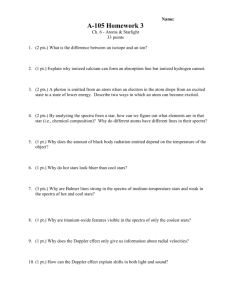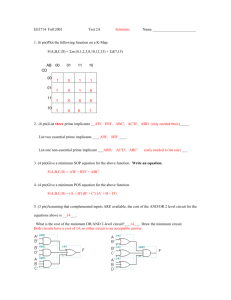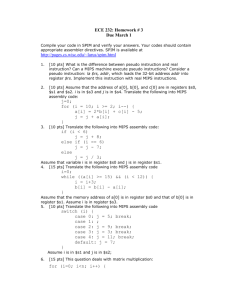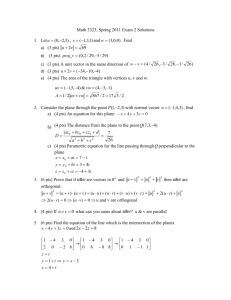44problemset1-solutions
advertisement
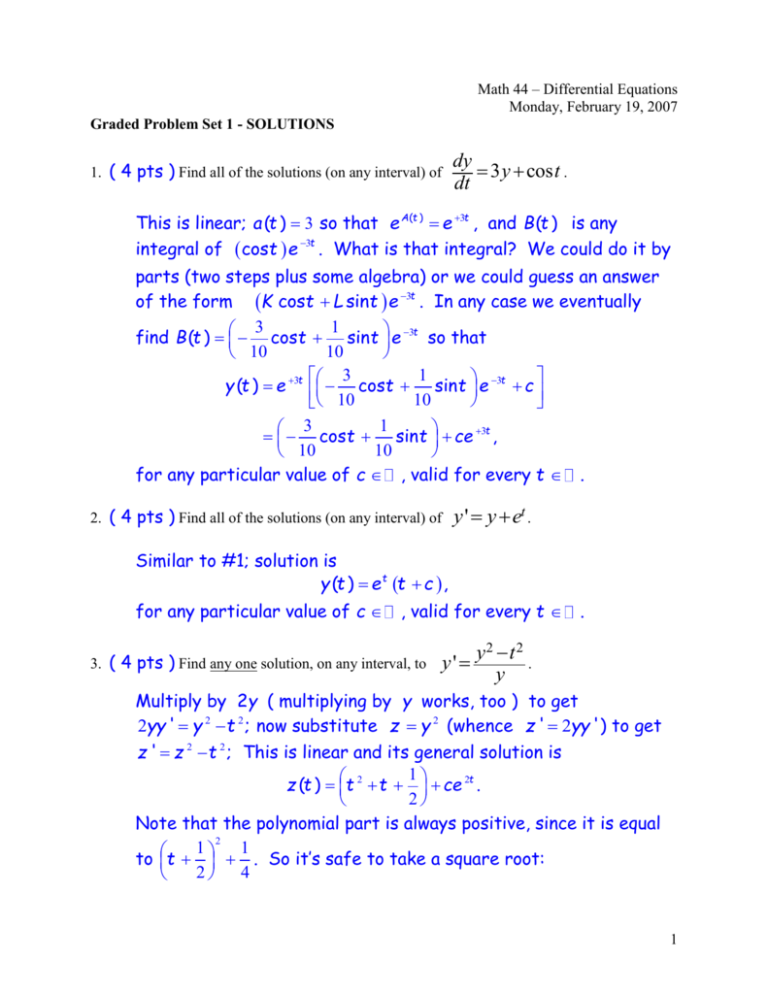
Math 44 – Differential Equations Monday, February 19, 2007 Graded Problem Set 1 - SOLUTIONS dy 3 y cos t . dt 1. ( 4 pts ) Find all of the solutions (on any interval) of This is linear; a (t ) 3 so that e A(t ) e 3t , and B (t ) is any integral of cost e 3t . What is that integral? We could do it by parts (two steps plus some algebra) or we could guess an answer of the form K cost L sint e 3t . In any case we eventually 3 1 find B (t ) cost sint e 3t so that 10 10 3 1 y (t ) e 3t cost sint e 3t c 10 10 3 1 cost sint ce 3t , 10 10 for any particular value of c , valid for every t . y ' y et . 2. ( 4 pts ) Find all of the solutions (on any interval) of Similar to #1; solution is y (t ) e t t c , for any particular value of c , valid for every t 3. ( 4 pts ) Find any one solution, on any interval, to . y2 t 2 . y' y Multiply by 2y ( multiplying by y works, too ) to get 2yy ' y 2 t 2 ; now substitute z y 2 (whence z ' 2yy ') to get z ' z 2 t 2 ; This is linear and its general solution is 1 z (t ) t 2 t ce 2t . 2 Note that the polynomial part is always positive, since it is equal 2 1 1 to t . So it’s safe to take a square root: 2 4 1 1 y (t ) z (t ) t 2 t ce 2t . 2 The problem asked for one solution, so you really aren’t done till you pick a value of c. The value c = 0 will do, so one possible answer is 1 y (t ) t 2 t , 2 valid for all t . NOTE: One solver noticed that this is a Bernoulli equation, with n = -1. So, problem #8 leads us to the substitution z = y2; it isn’t necessary to guess. 4. ( 4 pts ) (Beware, tricky) One solution to zero function, y1(t) = 0 for all t. y ' ty1/3 that is valid for all t is the Find another solution that is also valid for all t. This is a separable equation: dy / dt ty 1/ 3 y 1/ 3dy t dt y dy t dt 1/ 3 3 2/3 1 2 y t c 2 2 3/ 2 1 y t 2 c 3 This gives a solution valid for all t if the constant c is chosen greater than or equal to zero. So two possible answers are 3/ 2 1 2 y t 1 (valid for all t) and just 3 1 y 3 3/ 2 t3 (valid for all t). 2 (Choosing c < 0 would not work, because the resulting function would be undefined for values of t near zero.) This problem was supposed to be tricky, because I intended to add the initial condition y(0) = 0. The last solution above would still have been valid. It would have called attention to a failure of uniqueness, because here we have two solutions, y 0 and 1 y 3 3/ 2 t 3 , both of which satisfy the condition y(0) = 0. dy t 1 dt y 1 2 2 5. ( 4 pts ) If y(0) = 0 and whenever y > –1 , what is y(3) ? The fast way to do this one is to notice that y = t is a solution satisfying the initial equation, so the answer is y(3) = 3. You might worry that y = t is not the only solution satisfying the initial condition. In that case you can either (a) notice that the equation is separable, solve it, and see that no other solutions f have y(0) = 0; or (b) notice that is continuous whenever y y > -1, so the uniqueness theorem applies and two different solution curves can’t intersect. Numerical Techniques 6. ( 4 pts ) Consider again our old friend, y ' y2 t 2 with y(0) = 0. Estimate y(1) to an accuracy of 0.001. You may use software. You may use Euler’s method or any other method, but please don’t mention Bessel functions. From that old Mathematica workbook which gave the Bessel function solution, we get 3 y ( 1 ) ≈ 0.35023184431675577785. Here’s an Euler’s-method solution using step size 0.001. This is from Excel. t y(t) y'(t) increment 0 0 0 0 0.001 0 0.000001 1E-09 0.002 1E-09 4E-06 4E-09 0.003 5E-09 9E-06 9E-09 ………………………………………………… 0.997 0.346255 1.113902 0.001114 0.998 0.347369 1.116669 0.001117 0.999 0.348486 1.119443 0.001119 1 0.349605 1.122224 0.001122 Each entry in the “y’(t)” column is y(t)2+t2 from the same row; each “increment” is 0.001 times the number to the left of it; and each entry in the “y(t)” column (after the first) is the previous row’s y(t) plus the previous row’s increment. There is no way to tell from this calculation that the answer (0.3496…) is correct to within 0.001, so you would have to try an even smaller “delta-t” to have any confidence in the answer. Qualitative Techniques 7. Here’s a graph of (y – y ), as a function of y y – y3 3 Note that (y – y3) = 0 when y = 0, +1, or –1. y Note that ety is always positive. Consider the equation y ' ety ( y y3) . a. ( 4 pts ) Make a reasonable drawing of the direction field. (Use software if you like. You can re-draw the direction field by hand or, if you can get your software to print, turn in a printed image.) 4 Most people did this (and part b) by typing the equation into HPGSolver, which made it pretty easy. To do it by hand you would have to notice… (1) The directions are horizontal when y = 0, +1, or -1; and indeed, there are constant solutions at these levels. (2) These lines divide the plane into four bands, and the slopes are respectively negative, positive, negative, positive in the bands (from the top). (3) When y > 0, the directions get (much) steeper as you move to the right. When y < 0, they get steeper as you move to the left. b. ( 3 pts ) In the drawing, show three separate solutions y1, y2, y3, with y1(-1) = ½, y2(0) = ½, y3(+1) = ½. The points here are that all the solutions are in the second band (between y=0 and y=1) and are increasing; and that the solutions get steeper as you move to the right. c. ( 1 pt ) Estimate y2(100) to an accuracy of 0.000000000000000000000000001. (No proof required. Don’t use a calculator or computer for this part.) y2(100) = 1, to many more decimal digits than shown. Substitution 8. Here is “Bernoulli’s equation:” y ' a(t ) y b(t ) yn . It would be a linear equation, if only that pesky factor yn were missing from the last term. (Let’s take n to be any integer constant other than 0 or 1.) a. ( 1 pt ) If the functions z and y are related by z (t ) ( y(t ))k for every t, (where k is a constant to be named later) then what is y in terms of z? y(t) = _______z1/k_____________ (Careful --- NOT z-k.) b. ( 1 pt ) What is y ' in terms of z and z ' ? y '(t ) = ______ (1/k) z(1/k)-1 z '(t ) 5 c. ( 2 pts ) Using the results of (a) and (b), restate the original equation in terms of z’, z, and t. (y should not appear.) z ' = ka (t )z (t ) kb (t )z (t ) n 1 1 k k d. ( 2 pts ) What must k be in order for the answer to part (c) to be a linear equation? For the equation to be linear, we need for that last exponent to be zero. So k = 1 – n. e. ( 4 pts ) Use this approach to find any one solution (on any interval) to y ' y et y 4 . The substitution is z y 1n y 3, and then we have 1 y z 1/ 3, y ' z 4 / 3z ', and the equation becomes 3 1 z 4 / 3z ' z 1/ 3 e t (z 1/ 3 )4 3 which simplifies to z ' 3z 3et . This equation is linear and has the general solution 3 z (t ) e t ce 3t 4 whence 1/ 3 3 t 3t y (t ) e ce . 4 Pick any value of c … say, c = 0 … and simplify: 1/ 3 3 y (t ) e t / 3 , valid for all t. 4 An Application 9. The Dresden speaker (Trachette Jackson) gave the following equation for the number of tumor cells in a non-vascular tumor, N(t), as a function of time t: dN r1C 2 N r 1 C 2 N 2 . 2 dt c12 C 2 c22 C 2 6 In this equation, N(t) is an unknown function defined and continuous for t ≥ 0, and r1, r2, c1, c2, and C are all known constants. In the model, N(0) is assumed to be a very small positive number. a. Using the results of problem 8 OR the techniques from the example(s) at the end of Section 1.1, find the general solution to this equation (at least for N > 0). The big constants are awkward, so rewrite the equation as N ' aN bN 2 . This is separable, so you can solve it that way; also, it’s a Bernoulli equation, so you can solve it using #8 with the substitution z = y-1. In any case, the solution is a logistic function N (t ) 1 (a / b ) e at And its graph (for N(0) small positive) looks like this… The population levels off at N(t) = a/b. Given the known values of the constants, this is NOT usually a dangerous size for a tumor, so if we knew how to guarantee that tumors remained non-vascular, and therefore subject to this equation, we would be much healthier. b. Draw a rough graph of a particular solution for which N(0) is a small positive number. (end) 7








